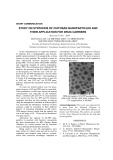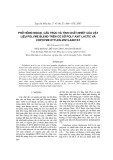
Biodegradable polymers
-
The aim of this research project "Development of polylactic acid-polyhydroxybutyrate blends for packaging applications" is to examine the effect of temperature and concentration on the rheological and thermal properties of PLA/PHB blends as well as recommending the optimum composition of the PLA/PHB blends for use in packaging applications.
 76p
76p  runthenight04
runthenight04
 02-02-2023
02-02-2023
 7
7
 2
2
 Download
Download
-
In this communication, we report the synthesis of chitosan (CS, a biodegradable and biocom- patible natural polymer) [1] nanoparticles as drug carriers by ionic gelation. The method is based on ionic interactions between positively charged groups NH3 + of CS (in dilute CH3COOH solution) and negatively charged of sodium tripolyphos- phate, TPP).
 2p
2p  uocvong04
uocvong04
 24-09-2015
24-09-2015
 84
84
 3
3
 Download
Download
-
Polylactic acid is one of the most popular bioplastics used in recent years and it is often mixed with other polymers or chemicals to form polymer blend because polylactic acid is able to accelerate biodegradation of polymer blends. This paper presents some results of study on polymer blend based on polylactic acid (PLA) and ethylene-co-vinylacetate copolymer (EVA).
 5p
5p  uocvong01
uocvong01
 24-09-2015
24-09-2015
 92
92
 9
9
 Download
Download
-
Biodegradation Plastic là nhựa được phân hủy sinh học và thường được sản xuất chủ yếu hoặc hòan tòan từ nguồn tài nguyên tái tạo được. Tài liệu tham khảo nhựa phân hủy sẽ mang đến cho bạn những kiến thức thú vị về loại vật liệu sinh học có thể tự phân hủy trong thiên nhiên mà không ảnh hưởng đến môi trường.
 17p
17p  huwngnguyen11
huwngnguyen11
 06-02-2014
06-02-2014
 232
232
 66
66
 Download
Download
-
Khối bùn nhầy kết cụm (Viscous bulking): do sự phát triển quá mức của các tế bào polymer sinh học lớn (extracelluar biopolymer). Chúng sinh ra chất nhầy và các chất nhầy làm chúng bám với nhau thành khối rất chặt. Các tế bào này rất ưa nước nên làm cho bông bùn khó tách nước, bùn lắng chậm và khả năng nén bùn không tốt. Ta thướng gặp ở hệ thống có nồng độ ch6át dinh dưỡng thấp hay nước thải có nồng độ rbCOD(readily biodegradable chemical oxygen demand) cao...
 11p
11p  iiduongii8
iiduongii8
 07-05-2011
07-05-2011
 281
281
 86
86
 Download
Download
-
Scaffolds A scaffold provides a three-dimensional framework to support the tissue or organ-specific cells. The scaffold not only provides mechanical support, but it must also supply critical nutrients and transport metabolites to and from the developing tissue. Important scaffold properties vary depending on the tissue but typically include specific biomechanical properties, porosity, biocompatibility, and appropriate surface characteristics for cell adhesion and differentiation. Scaffolds can be natural materials or synthetic polymers and are typically biodegradable.
 5p
5p  konheokonmummim
konheokonmummim
 03-12-2010
03-12-2010
 100
100
 7
7
 Download
Download
CHỦ ĐỀ BẠN MUỐN TÌM


















